
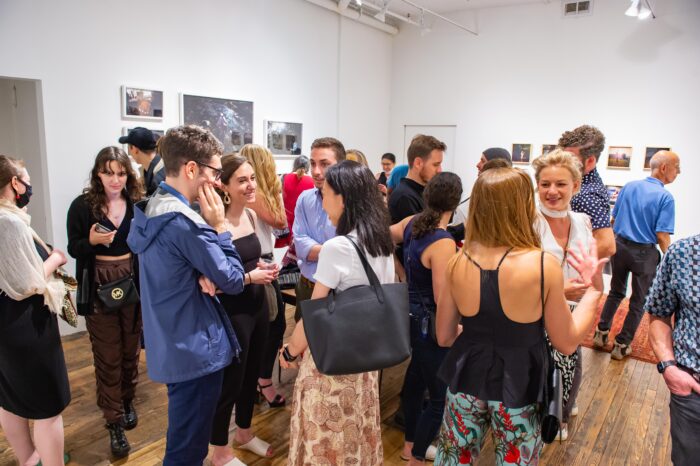
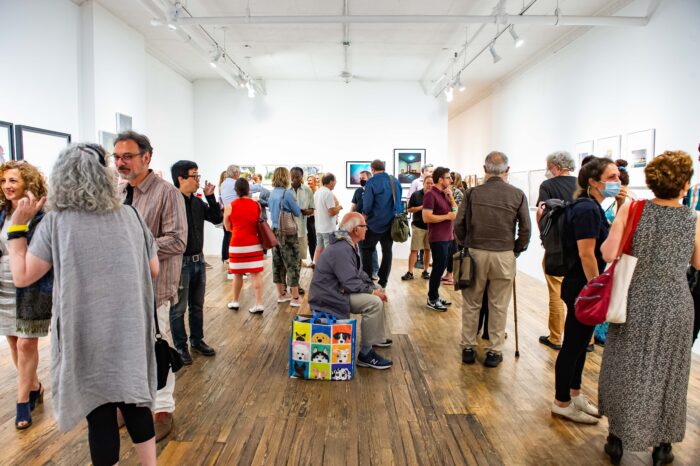

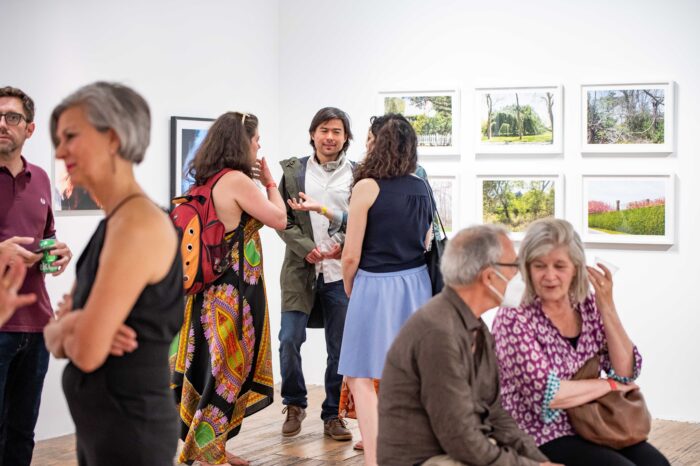

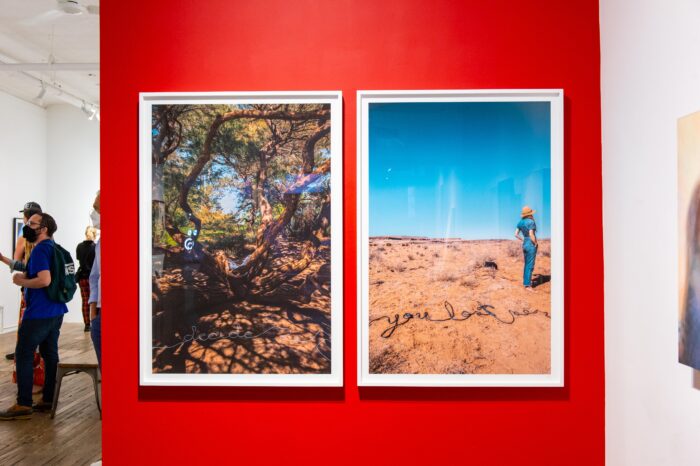
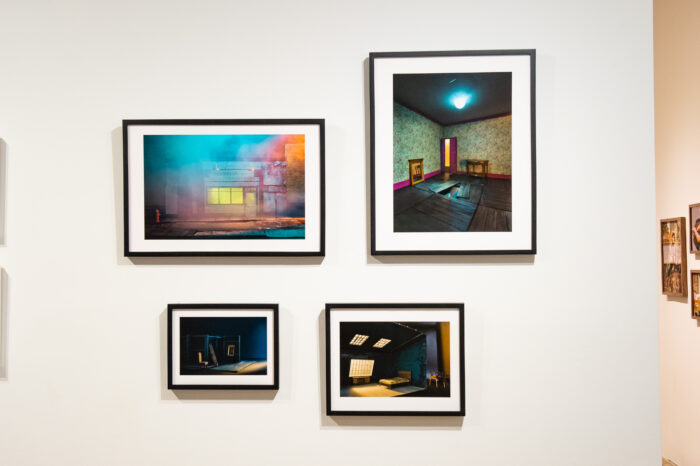




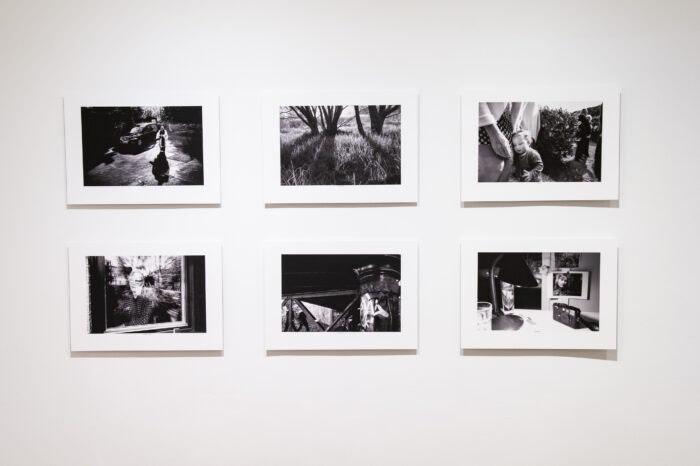
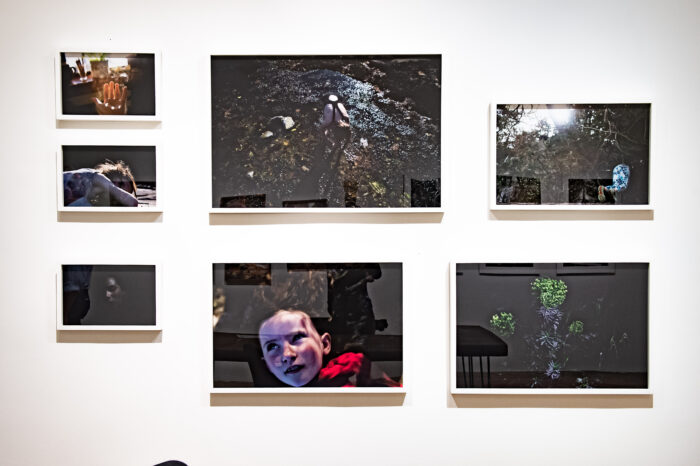

The Exhibition Lab Exhibition at Foley Gallery
July 8 – July 29, 2021
Photography courtesy of Jane Kratochvil
PR: Foley Gallery is pleased to present the 2021 edition of “the Exhibition Lab Exhibition,” a group show featuring work by Becky Wilkes, Beth Galton, Bootsy Holler, Christopher Fisher, Elizabeth Clark Libert, Fiona Aboud, Jon Plasse, Kathryn Weinstein, Lara Alcantara, Lisa Cutler, Mark Peterman, Mayita Mendez, Peter Essick, Rob Farrands, Robert George, Sara Wight, Takako Kido, and Ted and Nune.
The exhibition will feature photographers exploring various genres, from documentary to new media forms, including NFTs.
After 67 years of marriage, COVID-19 created an un-survivable situation for Becky Wilke’s parents. Wilke’s Mom, recovering from a recent stroke, lived “independently” separated from her Dad, newly placed on hospice in the same facility. When lockdowns eliminated their support, she moved them to her home.
Newly reunited, Wilke’s discovered her parents’ devotion to one another. Rarely were they separated by more than a few feet. They moved as one unit canvassing the driveway, hallway, and dock with their walkers, spooning one another as they slept.
Like many, Beth Galton struggled to process the sheer magnitude of the Coronavirus. At the beginning of the pandemic, she spent every day on the NY Times website, obsessively tracking Covid-19’s spread. However, she grew concerned that the headlines, charts, and graphs used to convey the scale of the virus were unequipped to represent the actual emotional toll that the virus took. So Galton began collecting and photographing these fragments of the news, hoping to imbue these numerical figures with the humanity they sought to represent. Covid Diaries is a visual diary of Covid, the politics of the time, and how they affect our everyday lives.
Bootsy Holler’s series CONTAMINATED is a layered historical exploration of the people affected by the secrets kept by the United States Government during the Manhattan Project, their subsequent illnesses, and the polluted land they served on.
As the Hanford reactors were decommissioned at the end of the Cold War in 1990, years of weapons production had left behind 53 million gallons of high-level radioactive waste. To this day, the Hanford Site contains two-thirds of the United States’ radioactive waste – and is the country’s most extensive environmental cleanup to date.
Christopher Fisher’s work begins with photographs of loose graphite on paper, then working on their surface with dry pigment, razors, and an anvil he found in his basement. Altering the original image attempts to reflect on how memory is elusive, shifting and muddling over time. Pigment loosens and falls, intentionally, as a reminder of vulnerability, loss, and decay.
The anvil represents the weight we all carry while lending a metallic shimmer to the pigments, shavings, and paper — an acknowledgment of future possibilities, creating pieces that explore the confluence of past and present, trauma and hope.
The collection of photographs by Elizabeth Clark Libert is an observation of her two young sons as they play in a verdant outdoor world. Our cultural response to male behavior is often, “boys will be boys.” Yet, while she frequently witnesses her sons’ affection for aggressive play, they can also be sensitive and sensual. As their mother, she struggles with their behavioral dichotomy. Their wild spirit entrances and concerns her—these parental anxieties are plaguing, questioning what is primal versus cultivated.
Fiona Aboud’s work is formally innovative and socially engaged, expanding the syntax of photographic art as a means of fostering new and powerful varieties of empathy and acceptance in a period of fragmentation and unease. Aboud makes abstract pieces with portrait photography using both digital and 3D processes. She creates surrealistic worlds that help us envision more nurturing relationships with others and with ourselves.
The pandemic continued into winter, falling snow enveloping him isolating him even further from the outside world. Prompted by this solitude, Jon Plasse began photographing the very familiar objects and places around his home. He does not seek to report, but rather to evoke, to create a sense of the elemental rhythms in our lives, presenting the subjects of these photographs in relation to the light and shadows that surrounded them—photographing what wasn’t there as much as what was there. Contemplating, and reflecting upon, the emanating light.
Tenure describes the act of holding or possessing and the status granted after a probationary period that protects one from dismissal. A meditation of home and husband, Kathryn Weinstein crafted scenes from her latter-day marriage. Ebbing and flowing in a universe the size of a house, they circle each other as measures in time.
Lara Alcantara’s work concerns introspection and how women go through more obstacles than men to prove their point and get their voices heard. Alcantara chose images that, in an isolated way, result in a direct, excruciating, stabbing, restless, and even unpleasant experience. Together they achieve a narrative quality in which Alcantara invites the spectator to take an honest trip to the visual reality that she makes of her contemporary life. The imagery presented through ropes and handwriting in nature and the artist placing her body and soul into the image results in identifying the self.
During the Covid-19 pandemic, the momentum of daily life slowed down. The familiar transformed into a new kind of magical discovery outside for solitary expeditions, as if witnessed for the first time.
It was a time to stop and look at the details in Lisa Cutler’s familiar environment. She felt like a child who, with each step and each moment, caught fresh glimpses and new discoveries. Hidden Homes are discoveries and surprises, sometimes humorous, that one can find in their own quiet and solitude.
Mark Peterman’s series Constructed Realities is a study in perception of reality. The series comprises fictional scenes drawn from cinematic and literary influences, built with 1/12 scale sets and props. Each scene is a story within itself but part of a more significant journey through an interior landscape sourcing fragments of memory and dream. They contain an element of mystery and a general sense of unease. As the series progresses, questions about reality arise as the scale of the models is hinted at. At times the 4th wall appears to break, but the hidden hand is never fully revealed. The delicate play between perception and reality is the core of this work.
Mayita Mendez is an immigrant born in El Salvador and raised in NYC. Mendez has always felt a yearning to belong, alongside a persistent feeling of being caught between places, languages, and even contradictory senses of self.
Her work focuses on documenting these states and the transitions that take her towards them and away. This past year, she became a migrant again. Because of the pandemic, she moved to a small island in British Columbia, Canada. These photographs are part of a more extensive visual diary, searching for moments of magic and sacredness meant to be seen and felt.
Situated on the Piedmont plateau of the Eastern United States, Metro Atlanta is known as a “City in a Forest.” Scientific researchers have discovered that trees in a forest can sense their environment and “sleep” at night by relaxing their branches. Unfortunately, older urban trees have usually been orphaned by surrounding development and subjected to pruning and pollution that has stunted their growth. Residents of Atlanta today are living in the remnants of an old-growth forest. The photographs in Peter Essick’s Sleeping Trees appear to be both documents and metaphors of the fragile existence of nature in the urban environment.
In 2020, Rob Farrands developed the idea of making a book of personal images from family life – creating fresh images on subjects such as mother/daughter and the cross-generational connections in an extended family. This plan was given a sharp twist by the arrival of Covid, changing as it did our taken-for-granted experiences of close contact with those we love; and creating new understandings of distance, isolation, loneliness, and loss of physical closeness. Rob’s evolving plan took on added purpose as I saw an opportunity to enrich the experience of human contact with imagery that reminded us of who we were just as we were struggling with a global threat to our existence.
Television sets transmit relic radiation from the Big Bang, like an afterglow. What emerges in these photographs are digital markings and machine language, bits of screen life, the legible chatter, and genetic code from the beginning of time. These portals to a new world are whispers from the universe waiting for interpretation. As the pandemic surged, Robert George pivoted his attention to making images of the ubiquitous screens that populate our lives: widescreen televisions, computer monitors, smartphones, etc. George re-photographed his own images enlarged on screens and sifted through old movies and news broadcasts. He made thousands of photographs, moving even closer to the intimacy of their displays.
The need for healing is universal and continuous. After the loss of Sara Wight’s father 18 years ago, she began photographing landscapes as a form of meditation. It provided an acceptance of the impermanence of life within an ever-changing and regenerating natural world. As Wight traveled, she found that landscapes reveal more similarities than differences. For example, a lake in upstate New York shares an essence with a lake in China’s Yunnan Province, as an inlet in Scotland does with the Mediterranean off of the coast of Sicily. Their colors and characteristics reveal a universality that lays the foundation for healing and connection.
Skinship is a Japanese word that describes the skin-to-skin relationship between a mother and a child or family. Through an experience of loving touch, a child learns caring for others. Japanese skinship is considered essential for strengthening the bond of family and the child’s healthy development. The idea of skinship was natural to Takako Kido as a Japanese woman. However, it was only after she was arrested in New York because of family snapshots, did she realize how unique and shocking it was in other cultural contexts. Living in both Japan and America showed Kido a cultural comparison and paradox clearly. In Japan, Kido gave birth to her son in 2012. Photographing her son growing up and enjoying skinship enabled healing of an old wound.
Ted and Nune’s project The Crawlspace is a conceptual photographic project in which subjects are invited to descend into a crawlspace where short candid video clips are projected on and around them. These candid clips are taken by the subjects themselves or by the artists. This project was conceived during the pandemic as a momentary escape from the anxiety of the pandemic and separation from loved ones. The experience allowed their subjects to redirect their thoughts to another time and place. The crawlspace, isolated and dark under the house, transforms into an unexpectedly intimate space, where subjects share and re-live their memories. The abstract image is the synthesis of a subject, video, and location.
The Exhibition Lab is a platform to study photography outside of a traditional academic setting. Michael Foley co-founded the initiative in 2010 as a study center for fine art photography dedicated to learning by critique. Students of the Ex Lab meet over the course of 5 months, holding critique sessions with one another and one-on-one sessions with Michael Foley. This year, Elinor Carucci and Jennifer McClure joined Michael as guest faculty.
“The Exhibition Lab Exhibition” will remain on view through July 29th, 2021. Foley Gallery is open Wednesday through Saturday, 11 – 5:30 pm. We will be closed Sundays in July. To request images, please contact the gallery at 212.244.9081 or [email protected].
